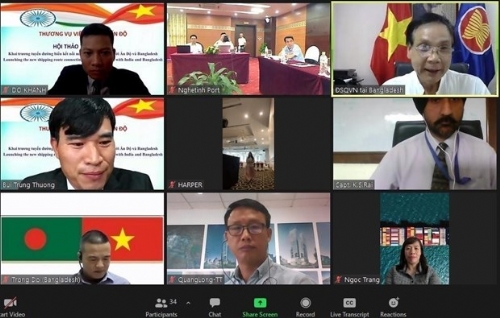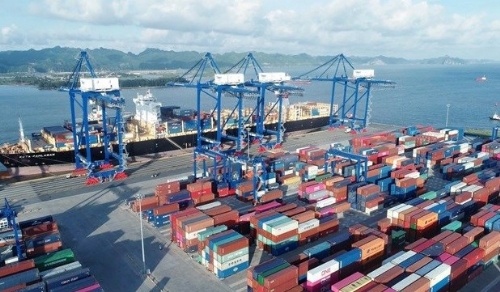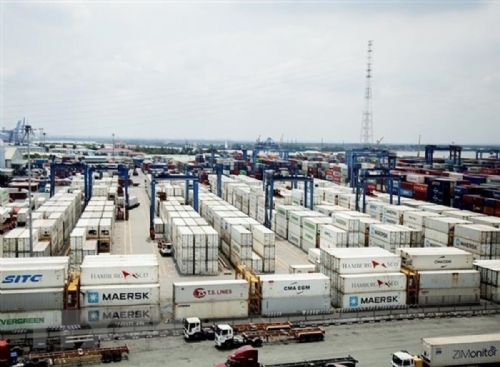Customs force struggles to prevent fraud of Vietnamese goods origin
Saturday, September 14, 2019 10:47
Be alert in all areas
At the Units of Customs Departments in provinces and cities,plans to strengthen the management of goods origin have beendeployed, especially in key areas such as Lang Son, Hanoi, Hai Phong and Ho Chi Minh City.
According to Lang Son Customs Department, because the area consists of many land border gates adjacent to China, some enterprises take advantage of open policies on e-customs procedures for import and export goods, transiting to import, transit of goods violating intellectual property rights and goods origin. Goods are often counterfeited for well-known foreign brands.The products that are often counterfeited are clothes, shoes, bags and electrical appliances.
Forecastingpotentialrisk, Lang Son Customs Department determines the responsibilities and objectives in the anti-origin fraud work, illegally conveying and counterfeiting goods labels to prevent fraud to protect consumers in the process of carrying out customs procedures for import and export goods. Focusing on checking goods owners' declarations on customs declarations on goods names, trademarks, origin, quality, labels, expiry dates of products, packaging and comparison with inspection results of actual goods with relevant documents in the customs dossier set.
The unit has instructed the border-gate customs departments to check and strictly control the border gate areato prevent origin fraud of consumer andfashion goods.Strengthening the inspection, examination and strict handling of violations such as smuggling and domestic circulation of foreign manufactured goods but attaching the label "made in Vietnam" to deceive consumers.
Ho Chi Minh City Customs Department has also defined the responsibility of the unit for anti-origin fraud, illegally conveying and faking goods labels to direct the Customs sub-departments to raise sense of responsibility in implementing tasks.
Determining areas of management without road boundaries with countries having high risks of origin fraud, therefore, the Customs Department of Ho Chi Minh City analyzes the risk of fraud for processing and export productionwhich enhances the collection of information related to goods and businesses through the sources: Customs database system (Customs professional information system; centralized electronic customs clearance system; information system of risk management, customs clearance system for ships and boats, system of collecting and processing customs professional information, lists of risks of import and export goods, other relevant information and data); from other information (customs professional stages; directive documents of agencies at all levels). The unit has directed subordinate customs departments to strengthen inspection of goods origin in accordance with the law. Post-clearance inspection department will strengthen the inspection of origin.
In Hai Phong, the province with largest cargo across the country, Hai Phong Customs Department has directed units to inspect and determine the origin of goods suspected of fraud and counterfeit goods labels. The inspection and identification of exported and imported goods shall comply with regulations. The unit carries out information about goods and enterprises in themanagement area suspected of fraudulent origin, illegally conveying and counterfeiting goods labels. It is promptly reported to the General Department of Customs about the cases of discovery of origin fraud, illegal transfer and counterfeit goods labels.
In addition, the work of coordination and information exchange with relevant units is particularly focused. Specifically, in coordination with Steering Committee 389, Market Management Department, City Police to promptly detect and prevent fraud origin,counterfeit labels in the area and take measures to regulate law.
Assessing risks–raising vigilance
Assessing the risk of infringement through origin of goods, Hanoi Customs Department also upholds vigilance and analyzes fraud to provide strict management solutions. According to Hanoi Customs Department, prediction of the main tricks of the suspects is that when they docustoms declarations,they do not declare trademarks, or declare origin and categoriesincorrectly. For imported goods, when packing goods to transport to Vietnam, the suspects often mix fake goods with real goods, packing or transport many kinds of goods with different brandstogether. The common goods infringing on trademarks and industrial designsinclude clothes, bags, shoes, fashion accessories, household appliances, electronics, furniture, wrist watches, phones, cosmetics, jewelry, traditional medicine, western medicine and food.
Therefore, in addition to being vigilant, focusing on analyzing risk factors to take management measures, Hanoi Customs Department proposes many solutions to control the origin, illegal transmission and fraudof goods labels.
In particular, ministries and agencies study to amend, supply and guide the implementation of regulations on intellectual property, origin, and goods labels to improve coordination mechanisms, strengthen market inspection and supervision, especially the issuance of certificates of origin of Vietnam for export goods, to avoid counterfeiting in Vietnam, ensuring uniform implementation across the country to create a legal "fence" strong enough for functional forces to control the market.
"Particularly for goods that need to be protected or have been built a brand of international stature, it is necessary to set specific criteria for products, build sanctions that are sufficiently deterrent to individuals and organizations trying to mistakenly state the wrong origin label,” Hanoi Customs Department proposed.
At the same time, the General Department of Customs has created a list of key items andenterprises to set risk criteria through each period in accordance with the new changes in tricks and violations of suspects; training,intensive training on intellectual property, counterfeit goods and counterfeit origin.
Along with Hanoi Customs, customs units also propose many solutions to strengthen management. Ho Chi Minh City Customs Department said that the Ministry of Industry and Trade needs to strengthen the granting of preferential C/O for export goods and connect data with customs authorities to serve the information collection for post-inspection.
The General Department of Customs builds a system to collect information to warn enterprises and goods that often have risks to warn on the system when registering declarations; at the same time, update information on the sample of the signature of the competent authority issuing C/O, even for organizations that self-certify origin forunits searching. Frequently exchanging information with associations and the domestic industry, it is possible to capture the output and types of products that can be produced or not in the country to enhance the inspection. Hai Phong Customs Department said that in addition to measures to strengthen inspection and control, it is necessary to disseminate information to individuals and organizations to know their rights and responsibilities in the protection of intellectual property rights and origin labelling.
Source: By Ngoc Linh/ Quynh Lan –Vietnam Customs News
Other news
- Shipping route connecting central Vietnam, India inaugurated(7/29/2022 11:22:05 AM)
- List of seaports of third-class and higher announced(7/18/2022 11:17:01 AM)
- HCM City approves 50% port infrastructure fee cut(7/12/2022 1:59:05 PM)
- Cai Mep port ranked 11th among the world’s most efficient container ports(6/13/2022 3:21:56 PM)
- Cargo throughput via seaports sees modest growth(5/25/2022 1:55:23 PM)
- USAID helps ease congestion at Cat Lai container port(5/23/2022 2:46:53 PM)
- Cua Lo Port receives first international container ship(5/6/2022 11:02:29 AM)
- Cargo through seaports rises 3 percent in four months(5/4/2022 10:40:35 AM)
- Vietnam seeks ways to boost logistics industry(5/4/2022 10:37:17 AM)
- Vietnam's logistics must keep up with international standards(4/26/2022 11:40:15 AM)





